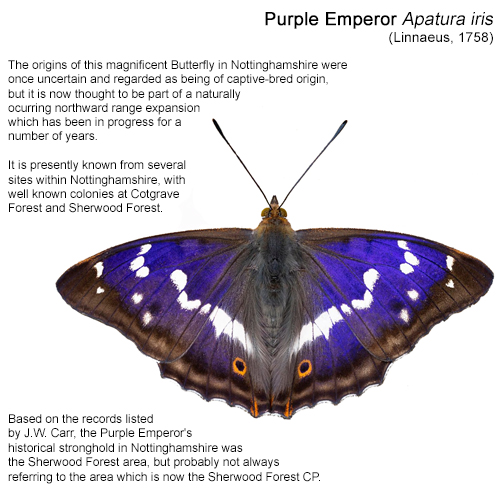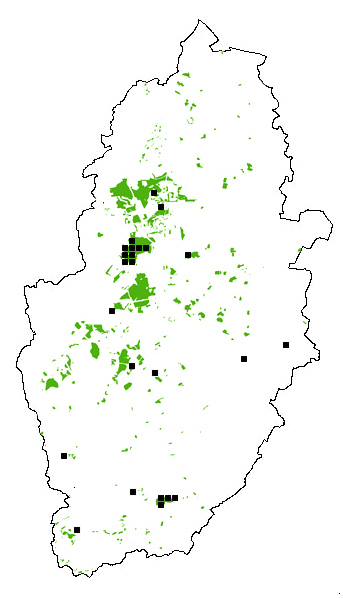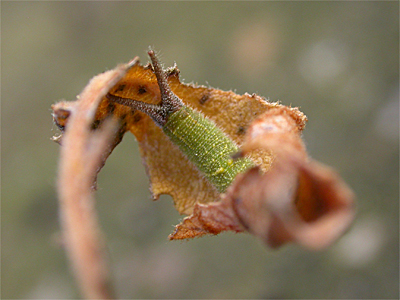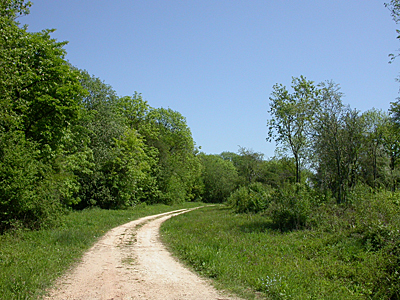

| The origins of the Purple Emperor in Nottinghamshire |
| .... |
| For a number of years always regarded as being
from released stock,
it seems that Nottinghamshire's Purple
Emperors do have more credible origins and their presence in the
county is at the very fore-front of a national northward range expansion. Because of the lack of any publicly published accounts of this impressive butterfly's range expansion in recent years, coupled with it's known range given as 'southern counties' in books, Purple Emperor records north of Northampton really were, for many years always to be viewed with suspicion and invariably chalked off as being of 'captive origin'. Accounts of the Purple Emperor's UK range never really varied (at least as far as I had ever read) from the books I studied back in my childhood and later during my peak 'butterflying' years of the 1980's. At that time, my only encounter with 'His Majesty' came at the end of a day's butterflying at Salcey Forest in Northamptonshire one afternoon, when on returning back to the car, there was a male Purple Emperor soaking up the pale blue of my friend's Skoda Estelle! We were stunned and delighted on finally seeing this mythical butterfly, but the sighting always had a downside to it, in that while I know now that the butterfly's credentials were definitely sound, we always had doubt in our minds that it was possibly a release. |
 |
|
| ..... | ||
| With most of the more well known
Purple Emperor populations found in Buckinghamshire, Northamptonshire and Oxfordshire
woodlands, it was in these counties that Gary Wilson and myself spent
many fine Summer days hoping to catch a glimse of what for us, a
somewhat mythical butterfly.
Bernwood Forest in Oxfordshire was our 'go to' site at that time really
and probably still is for many no doubt (although we never saw it), but
since the 1990's, Fermyn Wood in Northamptonshire has been considered
one of the best sites to see the Purple Emperor and we never got to go
there, as our lives and interests had changed by then. But since the 1980's and based on the distribution maps given in various books at that time, there has obviously been a considerable change in the Purple Emperor's northerly UK distribution. Recent records certainly show that the butterfly has moved northward through Leicestershire into both Lincolnshire and Nottinghamshire, but there are historical records and recollections of the Purple Emperor being seen in these counties. At the same time though, there's a vagueness to these records and over decades, what were almost certainly genuine records seem to have been forgotten, dismissed or just become accepted as simply anecdotal claims with no documenting evidence. |
||
| ..... | ||
 |
It is easy, even a large butterfly like
the Purple Emperor, to pass by unrecorded at a site for many years.
After all, this is a butterfly you're unlikely to see visiting flowers
and jostling for nectar amongst the Peacocks and Small Tortoiseshells.
Although they do come down to lower levels to take nutrients and salts,
if you're not looking for them when walking a site they're not known
from, the chances are that you'll never come across one. Dilys and myself visited Sherwood Forest on an almost daily basis from Spring to Autumn from 2008, yet never had a sniff of a Purple Emperor. Then again and despite knowing there were historical Purple Emperor records from Sherwood Forest, we never actually looked for the butterfly because we didn't expected it and with butterflies being so well recorded, we always thought that if they were on site, surely someone would have seen them. We obviously were'nt in the butterfly 'know' at the time and had no idea of any spread north, so had no cause to consider looking for it. Nottinghamshire's historical Purple Emperor records Question is, how long has the Purple Emperor been back at Sherwood Forest, or did it ever die out there in the first place? It's a question that could also be directed at the other known Nottinghamshire sites of Cotgrave Forest and Wellow Park. Sherwood's first returning(?) Purple Emperor was found by Nick and Samantha Brownley in 2020 and they continue to closely monitor the butterfly in all its stages, recording numerous individuals from ovae to adult. The butterfly has obviously been at Sherwood for a number of years and possibly arrived a year or two (or possibly at the same time?) as the butterfly was thought to have returned to it's old haunts of Wellow Park and Cotgrave Forest. The strange thing is that although apparently exsisting, no post-WWII Purple Emperor records get a mention in the available literature from any Nottinghamshire site - at least none that I've seen anyway. It seems secrecy once again abounds and despite the rumours, claims and typically vague records from at least Wellow Park and Sherwood Forest in the intervening years, none of these were openly published. But apparently, there were documented records for Sherwood Forest during the 1980's and even from nearby Clumber Park in the 1970's and 1980's (Mathers, S., Dell, D. and Jeffery, R. The Return of the Emperor: EMBC News 69 Autumn 2021). Why these accounts, or acceptable records never got published to a broader audience is a mystery and certainly neither Natural England or Sherwood Forest's former Nottinghamshire County Council management team, were ever aware of any records since Carr's publication in 1916. I do hate such unwarranted secrecy. |
|
| ..... | ||
| The area of Sherwood Forest
in which the Purple Emperor appears to be firmly established, is one of
the more quieter locations within the Forest, although not too far a
walk from the Major Oak. But with most of the books and available
literature emphasising the butterfly's preference for mature Oak
woodland with plentiful Sallow, where it is actually located at
Sherwood, isn't where most would expect to search for it, with the
majority of records coming from close proximity of a Pine Plantation,
rather than deep amongst the area's ancient Oaks. Although it was always possible that there was an element of under-recording due to this butterfly's arboreal habits, the Purple Emperor was never regarded as a common or widespread butterfly in Nottinghamshire and had seemingly declined to the point of extinction well over a century ago. J.W. Carr's species summary for the butterfly from his book 'The Invertebrate Fauna of Nottinghamshire. Nottingham: J.& H. Bell Ltd (1916)', opens with him stating that 'the Purple Emperor is now very rare and has not been taken recently'. He then continues by stating that 'this may be due to a decrease in the number of local entomologists, rather than a decrease of the butterfly'. Most of the records listed in Carr's book are from woodlands in the northern-half of Nottinghamshire, with Wellow Wood being particularly favoured. Carr states that it 'has been seen and taken many times in parts of the district' [Sherwood Forest]. He goes on to mention that he 'had one in his collection which was taken on Risebrigg Lane near Rufford; and that a few years ago 16 or 17 were seen within the course of a week at Wellow Wood, but only three or four were taken'. In 1859, a 'female was taken inside a pigstye near the edge of Wellow Wood and another was near Mansfield the same year (Brameld)'. |
||
| ..... | ||
Based on the number of records Carr listed, the Purple Emperor's Nottinghamshire stronghold was the Sherwood Forest area, but probably not always neccessarily referring to the area which is now the Sherwood Forest Country Park. Bear in mind that the Forest was once considerably larger than it is today and so a record with the site given as 'Sherwood Forest', may well have come from an area anywhere within a ten mile radius of Edwinstowe and was purely generalised by entomologists in their accounts. J.W. Carr in his later writing, says Sterland mentions that 'J. Trueman took several in the Forest', but there are no records from which Dilys and myself could ever determine were actually from within the Country Park. Carr also says that 'two males and a female were taken at Cossus (Goat Moth) borings in old Oaks in the Forest close to Edwinstowe in 1874 and a female was captured and two others seen in the same place in 1875 (Hardy)', but the location is unfortunately rather vague and not a great deal of use in terms of location accuracy. |
 |
|
| ..... | ||
|
The few other records that Carr lists in his original book, refer to 'the Winkburn Woods (Becher) and a few specimens have been seen over the tops of the Oaks in Theives Wood near Mansfield, one as lately as 1895 (Daws) and it was 'occasional near Newark' (which may refer to Langford Moor) where it was 'taken repeatedly' (Tomlinson). He belatedly adds a record of a 'female taken in the 1880's from Cocking Hill, Boughton near Ollerton' (G.B. Berkinshaw). Current distribution and status By early 2022, the distribution of the Purple Emperor in Nottinghamshire is in some ways confusing, but definitely different to that given for the county some 50 to 100 years ago. I can't remember any books on butterflies from my younger days that ever mentioned 'Purple Emperor and Nottinghamshire' in the same sentence. Nottinghamshire was never even given as a county with historical records, despite the records listed in Carr's book and the fact that the Purple Emperor did actually occur in the county, even if it was historically. The main difference in the butterfly's Nottinghamshire status today, is the increase in reported sightings and sites since 2020. This is something which would certainly be indicative that the butterfly is indeed continuing to expand its UK range. |
||
| ..... | ||
 |
The confusing aspect to the whole situation, is the apparent recolonisation of both Wellow Park and Sherwood Forest, but did the butterfly die out at both sites in the first instance? or (as often happens with invertebrates) merely exsist at both sites with low population levels? This would seem the most likely scenario and that the increase in local records coincides with the butterfly having had good breeding seasons in 2020 and 2021. Other species have certainly had a good couple of years, one of the most notable being Broad-Bordered Bee Hawk-moth, which suddenly turned up for the first time at two sites within the Sherwood Forest NNR and probably elsewhere too, while there are other species having similar fortunes. To be honest, if that one-winged Purple Emperor had not been found by Nick and Samantha Brownlee at Sherwood Forest in July 2020, we wouldn't be any the wiser now, not looking for Purple Emperors and I certainly wouldn't be writing this. The Purple Emperor population at Cotgrave Forest has been reported since 2015, but it was believed to have been present for at least a year or two before. There is still some confusion regarding the origins of the butterfly at this site and the term 'release' is still often touted around. Personally, I think it is more likely that it's there as part of a natural range expansion, which had been recorded over the border in neighbouring Leicestershire and Rutland by Richard Jeffrey. |
|
| .... | ||
|
There are no historical records from Cotgrave Forest and it was actually felled during WWII, presumably as part of the war effort. It was replanted a decade or so after the end of the war and if colonisation at Cotgrave Forest was indeed naturally occurring, it was likely earlier than is supposed. Remember, any species (sometimes no matter how obvious they are) can be easily missed, especially if it's not suspected as being there. Back in 2015 and 2016, genuinely wild Nottinghamshire Purple Emperors were last known from Wellow Park (showed above) many years ago, yet within living memory rather than historically. The man who could remember seeing them flying in the canopy there, was actually accompanying Martin White on a visit to Wellow Park looking for Purple Emperors in 2016, in an area where two had been seen by another observer the day before. Their visit coincided with Dilys and myself visiting Wellow Park on the same day, as it's a wood we regularly visited over a number of years but never recorded Purple Emperor there. Martin told us that he had released a number of larvae at Wellow Park in early 2016 and the year before, but he did tell us that his release of larvae was intended to augment the site's existing population. I still like to regularly visit Wellow Park, as it's as close as a Nottinghamshire woodland ever gets to those great butterfly woodlands of Buckinghamshire, Northamptonshire and Oxfordshire, although it sadly lacks those woods variety of species. Wellow Park still (to me at least) always has that 'feeling' of a great butterfly wood and I can't understand why it's not got a Fritillary or two patrolling its rides. And so Nottinghamshire once again has Purple Emperors breeding in Sherwood Forest and that's a great thing. Despite the butterfly's appearance believed to be one of those great birdwatching-like secrets that every birder tells their birding friend about, as payback for similar information they were given years before - word inevitably creeps out. In my defence, I was told about Sherwood's Purple Emperors in good faith and only when those reporting it knew who I was. The news was independently seconded by a friend a few days later, who casually enquired if I'd seen the Purple Emperors at Sherwood? Within a day or so, I'd found two ovae after a good hour's searching. One area in particular was mentioned as being best, but through the work of Nick and Samantha Brownley and a number of recorders and observers, the butterfly's range within Sherwood Forest has proved to be larger than first thought. But there are many locations at Sherwood which seem suitable for the butterfly and this is something to look into during future years. In 2021, there was a scattering of records from various other sites around Nottinghamshire. Interestingly, the butterfly was again reported from parts of the county where it was recorded historically. Purple Emperor records came from two sites in the Newark area (Farndon and Beacon Hill) which appear to be different sites to those Newark records listed by Carr in 1916. Another report came from woodland at Ratcher Hill Quarry at Mansfield, a site not far from where the butterfly was recorded historically at Thieves Wood. Purple Emperors were also recorded from Bramcote Park, Clumber Park and near Calverton during 2021. These records may not be indicators of breeding populations at these sites of course, so there's some potentially useful follow up work for someone willing to emulate the valuable work of Nick and Samantha Brownley. An interesting butterfly season awaits in 2022. It seems these are indeed, exciting times to be living in. References: Mathers, S., Dell, D. and Jeffery, R. The Return of the Emperor: East Midlands Butterfly Conservation News 69: Autumn 2021 |
||